This article was written exclusively for Investing.com
- Crude oil and oil stocks correct on July 19
- Crude oil and product demand is robust
- Crack spreads have moved appreciably higher- Rising profits for VLO
- Higher lows and higher highs since March 2020
When it comes to fossil fuels, the US's view is changing. On the day of his inauguration, Jan. 20, 2021, US President Joseph Biden canceled the Keystone XL pipeline project that carries petroleum from the oil sands in Alberta, Canada, to Steele City, Nebraska, and beyond to the NYMEX crude oil delivery point in Cushing, Oklahoma. Then in May, the Biden administration banned drilling and fracking for oil and gas on federal lands in Alaska.
As the US moves to address climate change via a greener path, the nation and world continue to rely on petroleum-based fuels that power lives and business. Over the coming years, increasing regulations will raise the cost of extracting oil and gas from the earth’s crust in the US. Moreover, it hands the pricing power for energy commodities back to the international cartel, OPEC, and its partner, the Russians.
While the US and Europe move to decarbonization, over one-third of the world’s people live in China and India, two countries that march to the beat of a different drummer. Moreover, in the US, most automobiles, trucks, planes, and other modes of transport, continue to require petroleum-based fuels. Rising demand in the wake of the global pandemic and falling supplies under the Biden administration’s green initiatives are bullish for oil and gas prices. Anyone with any doubt should look at the price trends in crude oil, natural gas, coal, and ethanol markets over the past year.
Nearby NYMEX crude oil futures recently traded at the highest price since 2014, at $76.98 per barrel. Natural gas rose to over $4 per MMBtu last week, the highest July price since 2014 and the highest level since late 2018, during the start of the peak heating season. Ethanol traded to its highest level since 2014 over the past weeks.
With demand rising, oil refining companies stand to profit. Valero Energy (NYSE:VLO) is a leading US refiner. The company's shares have moved close to $20 lower, now trading about 22.8% below their level on June 3. At $65.54 per share on July 26, VLO is back in the buy zone (at time of publishing shares were just a few cents higher).
The $3.92 dividend, or nearly 6% yield, makes the stock a compelling bet as it pays an above-market rate for those waiting for it to deliver capital gains.
Crude oil and oil stocks correct on July 19
Crude oil has a nasty habit of taking an elevator shaft lower during corrections. The most glaring example came in the first half of 2020 when the price of the commodity evaporated and fell below zero on NYMEX futures and to the lowest level of this century on the nearby Brent futures contract.
Since last April, the energy commodity has made higher lows and higher highs. The nearby NYMEX futures rose to the highest level since 2014 on June 6 at $76.98 per barrel. The now active month August contract reached $76.07 per barrel.
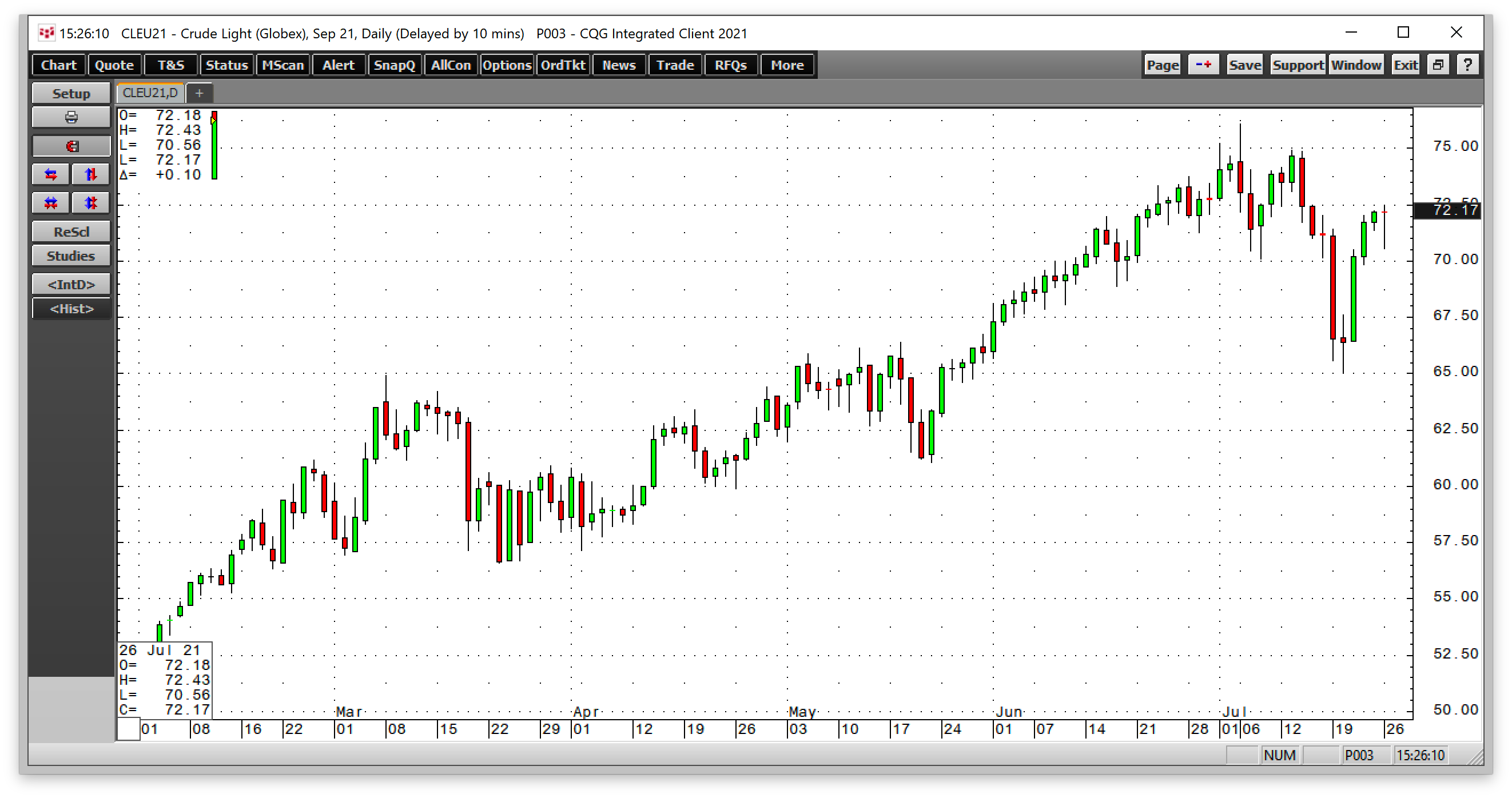
Source: CQG
The chart above highlights the decline from the high and the substantial drop on Monday, July 19, that took the August WTI futures to a low of $65.01 on July 20 before returning to over the $72 per barrel level. Crude oil dropped alongside the stock market, providing oil-related shares with a double bearish whammy of selling.
Recently, oil-related shares have been doing much worse than crude oil. The highly liquid S&P 500 Energy Sector ETF (NYSE:XLE) holds a portfolio of shares in the US’s leading oil and gas-related companies.
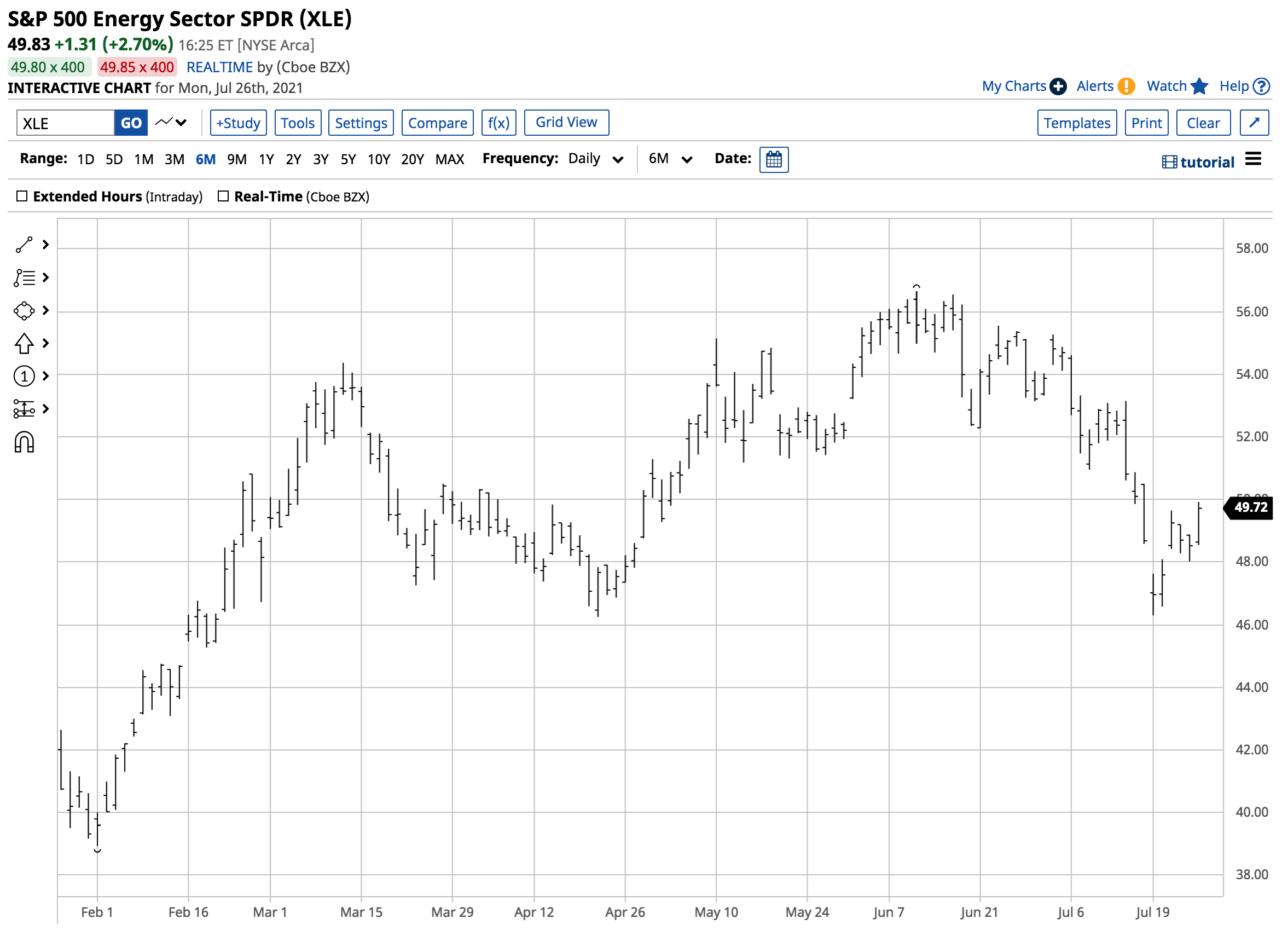
Source: Barchart
The chart shows that the XLE rose to a high of $56.65 on July 10 and fell to a low of $46.30 on July 19. The ETF gapped lower on July 19—the day crude oil prices fell down the latest elevator shaft.
Oil stocks fell by 18.3% from the high, while the August NYMEX crude oil futures price declined 14.5%. Crude oil was trading at the $72 per barrel level on July 28, 10.8% above the recent low, while at $49.83, the XLE had recovered by 7.6%. Oil-related shares have lagged the crude oil futures price as they fell more during the correction and rose less during the recovery.
The XLE has a 3.12% exposure to Valero Energy. The company refines crude oil into transportation fuels and petrochemicals and produces biofuel in the US, Canada, the United Kingdom, and Ireland. The company’s profile notes that it operates through three segments: Refining, Renewable Diesel, and Ethanol.
VLO has a market cap of $26.042 billion at $65.54 per share. The stock trades an average of 5.13 million shares each day. In 2021, VLO has traded in a range from $54.84 to $84.95 per share. At Tuesday's closing price of $65.58, the stock was closer to the low than the high for the year. As well, the stock has been headed lower since early June.
Three factors are signaling Valero is poised to head higher, making it a buy at its current price level.
1. Crude oil and product demand is robust
Vaccines creating herd immunity to COVID-19 have generated a demand boom as people are returning to work, vacationing, and venturing out into the world. Oil and oil product inventory levels in the US reflect the strong demand for traditional fuels.
According to the Energy Information Agency, crude oil, gasoline, and distillate stockpiles have declined from Jan. 1 through July 16, 2021.
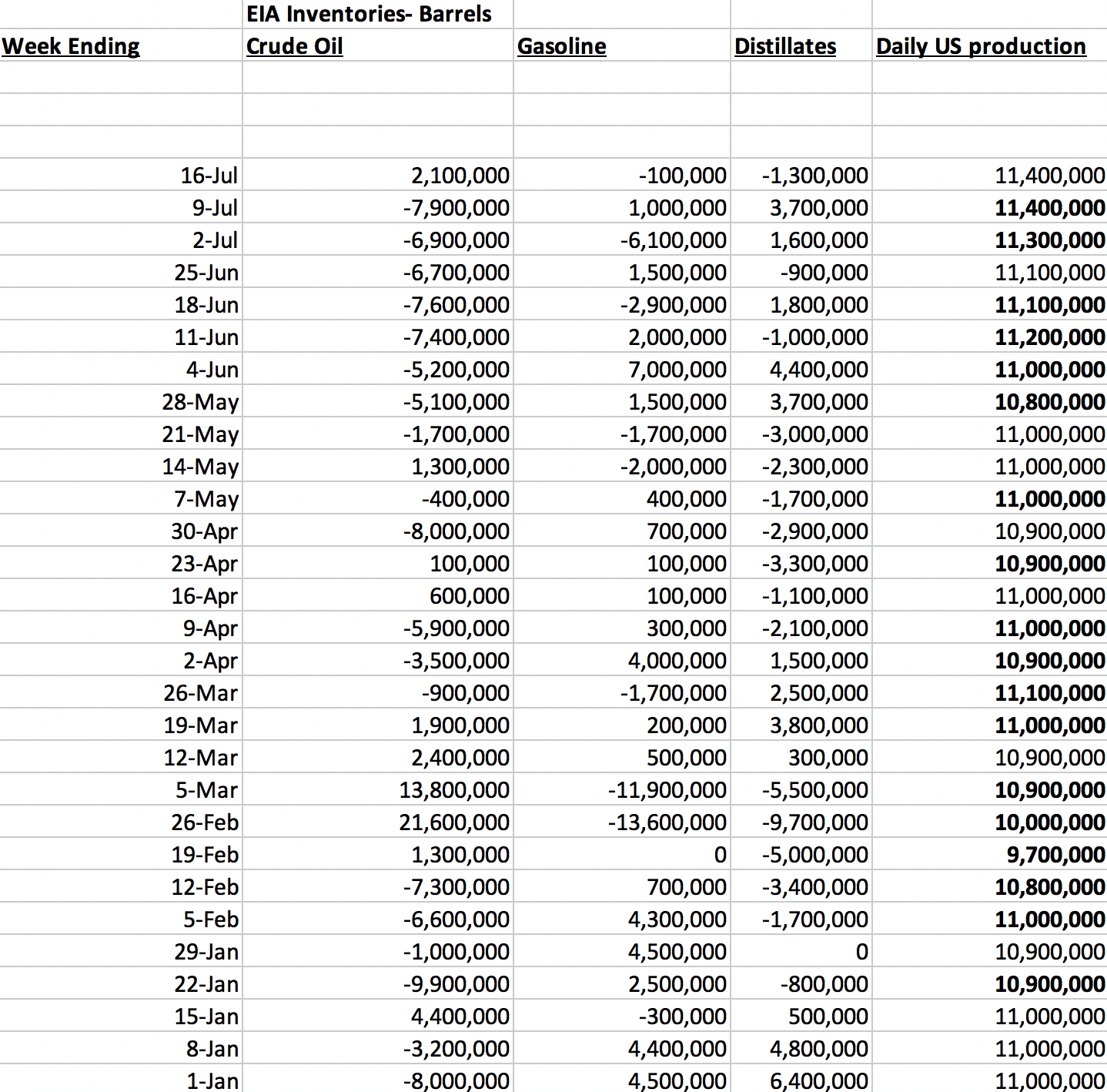
Source: EIA weekly data
Over the course of 2021, crude oil stockpiles declined by 53.7 million barrels, gasoline inventories dropped by 100,000 barrels, and distillate stocks moved 10.7 million barrels lower. US daily crude oil production increased from 11 to 11.4 million barrels per day since the end of 2020, a 3.6% rise. However, they remain 13% below the peak level of 13.1 mbpd in March 2020 despite the robust demand.
Rising demand for gasoline, heating oil, diesel, and jet fuels have caused refining spreads to move higher in 2021.
2. Crack spreads have moved appreciably higher, meaning rising profits for Valero
Crack spreads reflect the economics of processing a barrel of crude oil into a barrel of gasoline or distillate products. The spreads are a real-time indicator of demand for fuels and a barometer of profits for companies like Valero that process oil products. Rising crack spreads mean more profits for oil refineries. 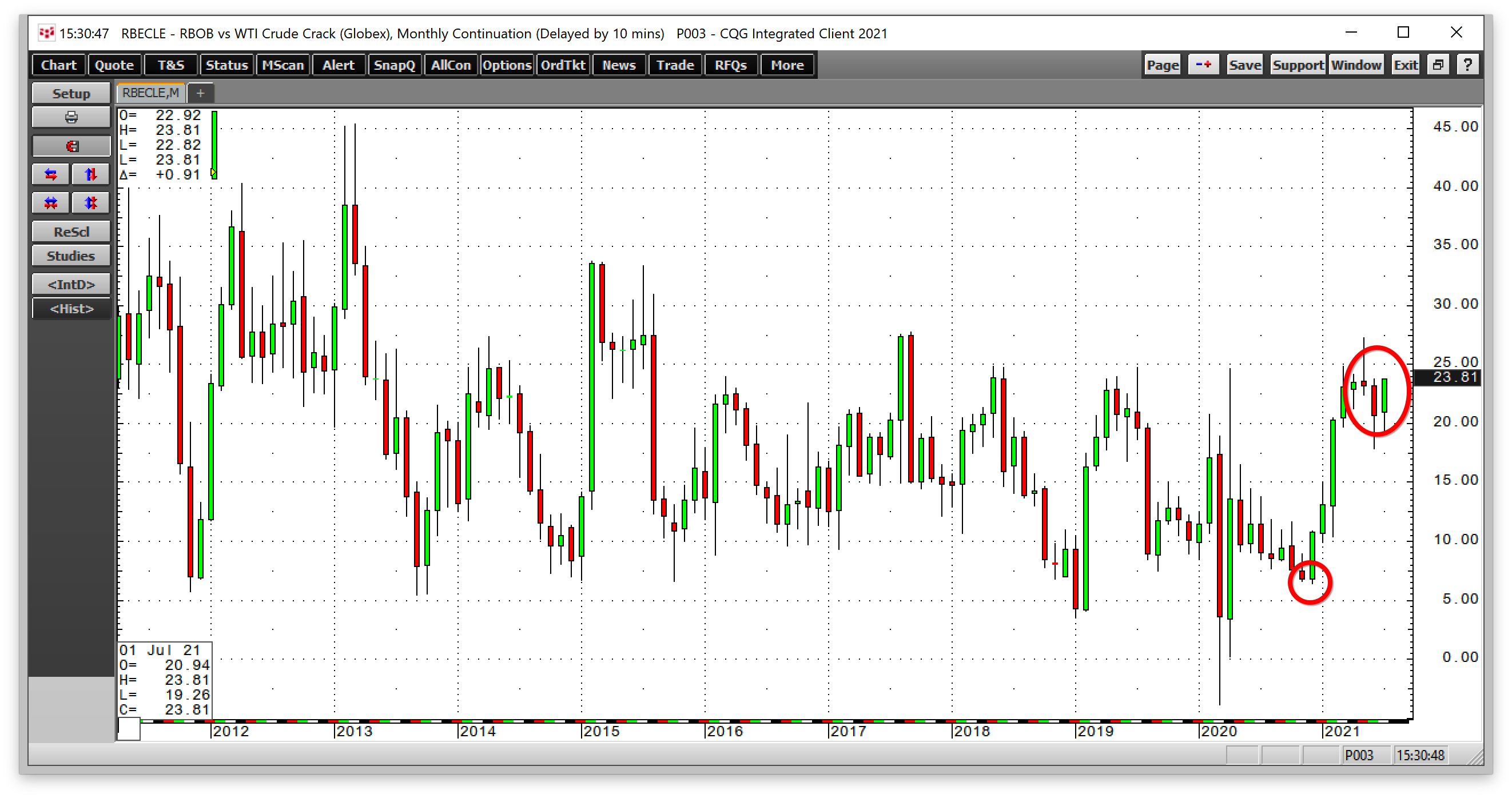
Source: CQG
The monthly chart of the gasoline crack spread shows it moved from $10.81 at the end of 2020 to the $23.81 per barrel level as of July 26. Gasoline is a seasonal fuel that tends to rise during the spring and summer months and decline during the winter when drivers put few miles on their automobiles.
In pandemic-ridden 2020, the gasoline crack spread was below the $14 per barrel level in July. 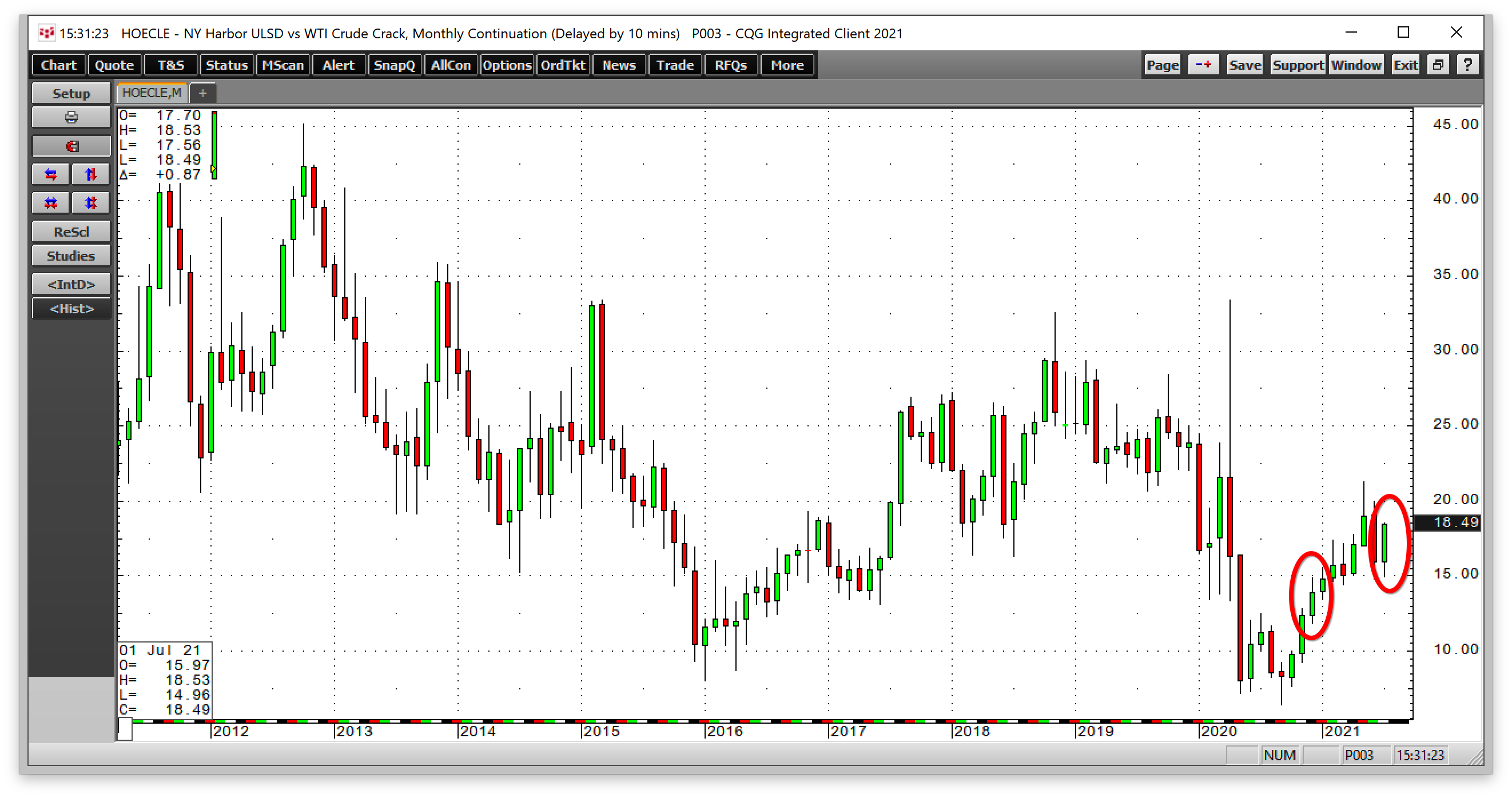
Source: CQG
Despite the name, heating oil crack spreads are a proxy for distillates like diesel and jet fuels. The distillate crack spread moved from $13.92 at the end of 2020 to $18.49 per barrel as of July 26. In July 2020, the distillate crack spread was below the $12.50 per barrel level.
Higher crack spreads translate to increased profits for VLO and other oil refineries. When it comes to biofuel, corn is the primary input in ethanol production in the US. At the end of December 2020, nearby corn futures were at the $4.8575 per bushel level, with nearby ethanol futures at $1.433 per gallon wholesale.
At $5.4575 on July 26, corn was 12.4% higher. Ethanol at $2.32, ethanol was 61.9% above its 2020 closing price. Since the input rose less on a percentage basis than the output, refining the coarse grain into biofuel has been an increasingly profitable business for VLO.
3. Higher lows and higher highs since March 2020
Valero may have pulled back from $84.95 to $65.54 per share, but the longer-term trend remains bullish. 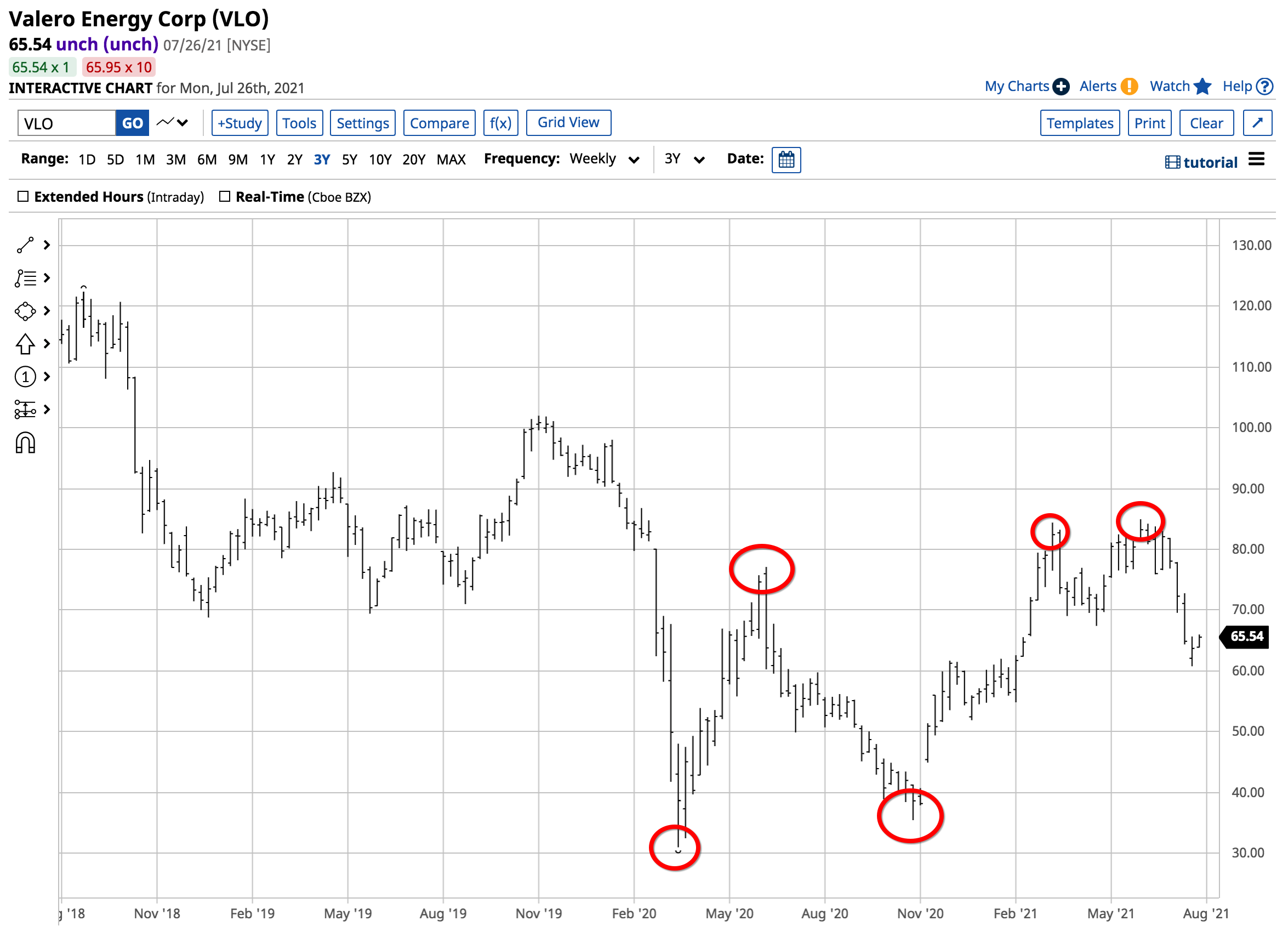
Source: Barchart
Valero shares have made higher lows, and higher highs since the stock found a bottom at $31 in March 2020. The stock made a higher low of $35.44 in October 2020, which is the critical support level.
I expect strong demand for oil products and strength in refining spreads to support gains in the shares. However, seasonality could mean VLO is susceptible to selling over the coming months as the winter approaches. I would be a scale-down buyer of VLO from the current level, leaving plenty of room to add on price weakness in the volatile stocks.
Meanwhile, Valero’s dividend at the $3.92 level translates to an above-market 5.98% yield. VLO pays shareholders to wait for capital appreciation.
The shift to a greener path for US energy means regulations for all traditional energy companies will boost production costs and curtail parts of the business. However, the US demand for crude oil and biofuels has been rising as vaccinations create herd immunity to the worst consequences of COVID-19.
It will take years, if not decades, to reach lower emissions standards and decarbonization. In the meantime, the US remains addicted to petroleum-based fuels, which is bullish for Valero shares at the current price level and below.
